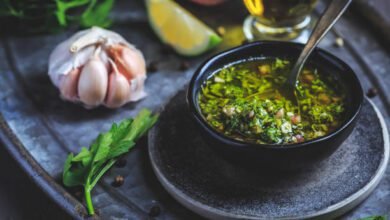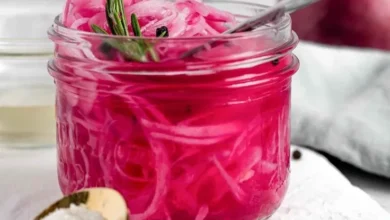Homemade Tex-Mex Seasoning: Spice Up Your Kitchen

Love Tex-Mex food? Me too! It’s comforting, delicious, and something I often make at home. Whether it’s tacos, fajitas, or a hearty chili, Tex-Mex Seasoning is my must-have spice blend. I always keep it in my pantry so that whenever a hankering for those bold flavors strikes, I’m ready to go.
Contents
Tex Mex Seasoning
While there are plenty of spice blends available at the store, making your own Tex-Mex Seasoning at home is surprisingly easy and saves time in the long run. Plus, it’s fantastic to know exactly what’s going into your food. With just a few simple spices, you can whip up a batch that’s even better than those pre-mixed jars – and you can customize it to your liking! So skip the store and let’s get creative in the kitchen.
Homemade Seasoning / Spice Mixes vs. Store-bought
Why make your own seasoning blends instead of relying on the store-bought variety? Here’s why:
- I can’t stress this enough – it simply tastes better. I’ve found that a homemade seasoning mix always outshines any pre-made variety in flavor and freshness.
- It’s fully customizable. Homemade seasoning blends allow you to fit your taste perfectly. Love heat? Increase those spicy ingredients. Craving earthiness? Add more cumin. Need a low-sodium option for a particular dish? Just reduce the salt.
- There’s no junk involved. When you make seasoning at home, you can avoid all the weird fillers and mystery ingredients. You’ll have a fresh list of ingredients that you can pronounce and feel good about using.
Tex-Mex Seasoning
Course: SeasoningsCuisine: Mexican4
servings1
minute300
kcal1
minuteTex-Mex Seasoning is a versatile blend of chili powder, cumin, and other spices that adds a burst of warmth and flavor to your favorite dishes. Whether you’re making tacos, fajitas, or just want to spice up your weeknight dinner, this homemade seasoning is a must-have in your kitchen.
Ingredients
1 teaspoon chili powder
1 teaspoon ground cumin
1 teaspoon ground coriander
1 teaspoon paprika
1/2 teaspoon kosher salt
1/2 teaspoon garlic powder
1/2 teaspoon dried oregano
1/4 teaspoon black pepper
Directions
- Once you’ve gathered your favorite spices, simply mix all the ingredients together in a bowl. Then, transfer the mixture to an airtight container or jar.
- Store your homemade Tex-Mex seasoning in a cool, dry place, and it will stay fresh for up to 6 months.
Tips For best Tex-Mex Seasoning
- Once you’ve made your Tex-Mex seasoning, feel free to make adjustments. You can add more or less of certain spices, or even remove ingredients based on your preference.
- Always store your spice blends in jars with a screw-top lid to keep them fresh for longer.
- Ensure your container is completely dry before use. If using a freshly washed container, make sure it’s 100% dry before pouring in the seasoning. To achieve a dry jar, wipe it with a kitchen towel, then place it upside down on a drying rack for 20–30 minutes. Any moisture left in the container could risk the spice mixture becoming spoiled.
- Mark the date on the jar when you mixed up the blend. This helps you track its age. Perform a sniff test if it’s getting older to determine if it’s still usable.
RELATED: Homemade Beef Rub
RELATED: Smoked Chicken Dry Rub
Storing
The vessel you choose to store your Tex-Mex seasoning in is crucial. It must be airtight to keep the blend fresh. Store it in a cool, dry, dark place, such as a pantry or drawer. When properly stored, your homemade Tex-Mex seasoning should stay fresh for up to 6 months. As long as it is completely dry, it will never go bad or rotten, but it may become a bit stale and lose potency over time.
Ways to Use Tex-Mex Seasoning
Your homemade Tex-Mex seasoning recipe is incredibly versatile! Here are a few ideas to get you started:
- Sprinkle it on beef, chicken, or burger patties before grilling for an instant flavor boost.
- Toss it with roasted potatoes or corn for a zesty side dish.
- Add a pinch to your popcorn for a fun, savory twist.
- Stir it into queso dip for an extra layer of complexity.
- Of course, it’s the perfect addition to any kind of tacos, fajitas, or burritos! Try it on my Buffalo Chicken Tacos, Bean Taco Soup Recipe, and Grilled Baja Shrimp Tacos.
Tex-Mex Seasoning Substitutes
If you don’t have all the ingredients on hand for homemade Tex-Mex seasoning, here are a few substitutes you can use:
- Taco seasoning: While not exactly the same, taco seasoning can be a decent substitute for Tex-Mex seasoning in a pinch. It generally has a higher concentration of chili powder and cumin, so you may want to use a bit less than you would Tex-Mex seasoning.
- Chili powder blend: If you have a pre-mixed chili powder blend that includes other spices like cumin, garlic powder, and onion powder, it can be used as a substitute.
- Individual spices: In a pinch, you can combine chili powder, cumin, garlic powder, and onion powder to create a simple Tex-Mex-inspired seasoning blend. Adjust the amounts of each spice to your liking.
Conclusion
So there you have it! With just a few simple steps, you can create your own Tex-Mex seasoning that’s fresher, tastier, and healthier than anything you’ll find in the store. It’s a small change that can make a big difference in your cooking.
_________________________________________
Frequently Asked Questions
What is Tex-Mex?
Tex-Mex is a unique style of cuisine that blends elements of Mexican and Texan cooking. It’s known for its bold, hearty flavors and the generous use of ingredients like chili peppers, cumin, garlic, and cheese. While inspired by traditional Mexican cuisine, Tex-Mex has its own distinct identity and has become a beloved culinary tradition in the United States and beyond.
Tex-Mex vs Mexican Food
While both Tex-Mex and Mexican food share some similarities, there are key differences:
- Ingredients: Tex-Mex often incorporates ingredients that are less common in traditional Mexican cuisine, such as wheat flour tortillas, yellow cheese, and canned ingredients.
- Flavors: Tex-Mex tends to be bolder and spicier than traditional Mexican cuisine, with a heavier emphasis on cumin, chili powder, and garlic.
- Dishes: Some dishes, like fajitas and chili con carne, are distinctly Tex-Mex and not typically found in traditional Mexican cooking.
What can I use this seasoning on?
Tex-Mex seasoning is incredibly versatile! You can use it to flavor everything from grilled meats and vegetables to tacos, burritos, fajitas, soups, stews, and even popcorn! Get creative and experiment to find your favorite ways to use it.
Can’t I just use these spices separately?
While you can technically use the individual spices separately, having a pre-mixed Tex-Mex seasoning blend offers several advantages:
- Convenience: It saves you time and effort by having all the spices pre-measured and ready to go.
- Consistency: It ensures a consistent flavor profile every time you use it.
- Customizability: You can easily adjust the amounts of each spice in your homemade blend to suit your preferences.
What is Tex-Mex flavor?
Tex-Mex flavor is characterized by a combination of warm, earthy spices like cumin and chili powder, along with savory notes from garlic and onion. It often has a bit of a kick from chili peppers, but the overall flavor is well-balanced and complex.
Is Tex-Mex the same as Taco seasoning?
While both Tex-Mex and taco seasoning share some similarities, they are not exactly the same. Taco seasoning typically has a higher concentration of chili powder and cumin, giving it a more intense flavor. Tex-Mex seasoning, on the other hand, is a bit more versatile and can be used in a wider range of dishes beyond just tacos.
What are the main ingredients in Tex-Mex?
The main ingredients in Tex-Mex cuisine include chili peppers, cumin, garlic, onion, oregano, paprika, and various types of meat (beef, chicken, pork). Cheese, beans, corn, and tortillas are also common ingredients found in many Tex-Mex dishes.
What is Tex-Mex chili seasoning?
Tex-Mex chili seasoning is a blend of spices specifically designed to flavor chili con carne, a hearty stew that is a staple of Tex-Mex cuisine. It typically includes chili powder, cumin, garlic powder, onion powder, oregano, paprika, and sometimes other spices like cayenne pepper or smoked paprika.






